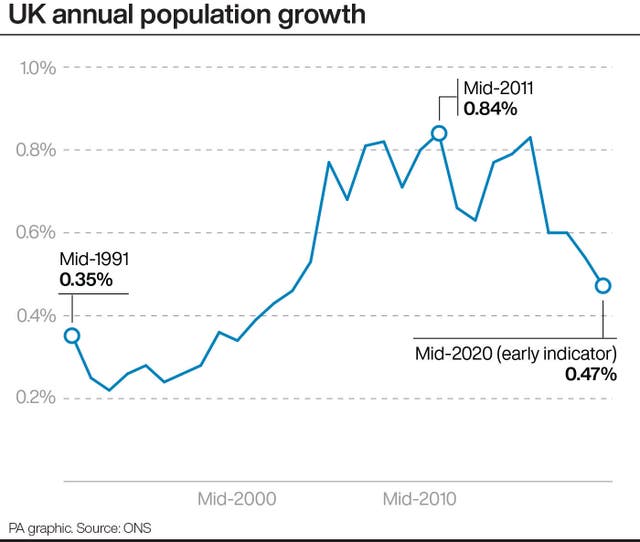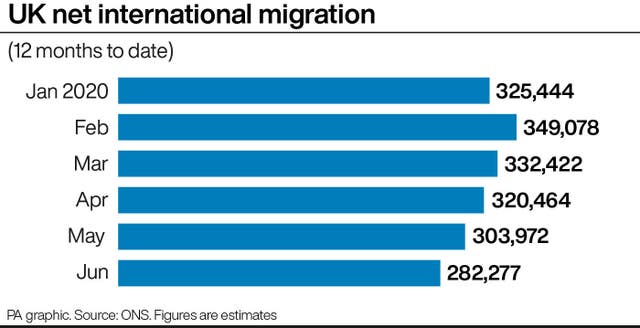UK population growth ‘slowest since 2003’, early figures suggest
Covid-19 travel restrictions are likely to have caused negative net migration in the early months of the pandemic.

The UK population may have grown by just 0.5% in the year to mid-2020 – the lowest annual increase since the year to mid-2003.
Early indications suggest the overall size of the population in mid-2020 stood at 67.1 million, up by 316,000 on the official estimate for mid-2019, according to preliminary data from the Office for National Statistics (ONS).
A 0.5% annual increase in population would likely reflect a higher number of deaths and a continued fall in the number of births being offset by a higher level of net international migration, the ONS said.
Total UK net migration for the 12 months to mid-2020 was 282,300 – although this largely reflects the pre-pandemic period.
When looking specifically at the patterns following the start of the pandemic in March 2020, there is a “notable change due to the impact of travel restrictions”, with negative net migration of around 50,000 for April to June, the ONS said.

Official estimates for the UK’s population in mid-2020 will be published later this year.
The ONS has also produced figures showing the potential size and structure of the UK population at the end of 2020 under various international migration scenarios.
Under a scenario of a net migration outflow of 100,000 during the second half of 2020, the population of the UK would be 67.0 million at the end of the year – below the early indicator of 67.1 million for mid-2020, but still above the official estimate of 66.8 million for mid-2019.
Liz McKeown, ONS director of public policy analysis, said: “The coronavirus pandemic has created a number of challenges for measuring the labour market, population and migration. At the same time there is significant interest in what impact the pandemic has had on the number of people living and working in the UK.
“These are early population indicators based on new methods. There is uncertainty and they will likely be subject to revision in the coming months, especially as more data becomes available. In this respect they do not represent official population estimates.
“But what they do provide are the very latest insights on what happened to the population and migration since the pandemic, using available data and new methods.”

The UK’s apparent switch from positive to negative net migration was described as “extraordinary” by Madeleine Sumption, director of the Migration Observatory at the University of Oxford.
“The pandemic dramatically disrupted migration patterns in the UK and there has been a lot of speculation about a mass exodus of migrants from the UK,” she said.
“There’s now a fair amount of evidence to suggest that emigration was lower than early data suggested. But what we saw in 2020 was still pretty extraordinary – after years of substantial net migration from EU countries to the UK, the trend appears to have gone into reverse.”
Ms Sumption also welcomed the new methods used by the ONS to estimate levels of migration, which incorporates data from administrative records such as taxes and benefits.
Analysis of the ONS data by the Migration Observatory suggests these new estimates have added an average of 93,000 per year to EU net migration from 2011/12 to 2019/20, while figures for non-EU migrants have been reduced by 54,000.
“After 2010, tight restrictions on non-EU migrants were significantly based on the premise that most net migration was from outside of the EU,” Ms Sumption said. “Today’s figures suggest that the real picture was quite different.”





